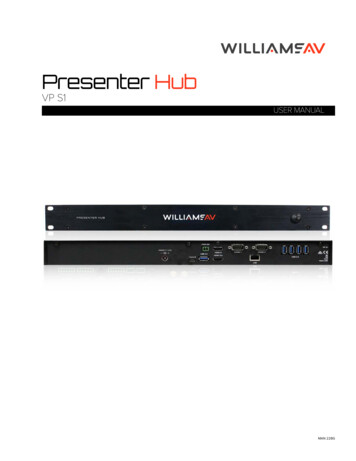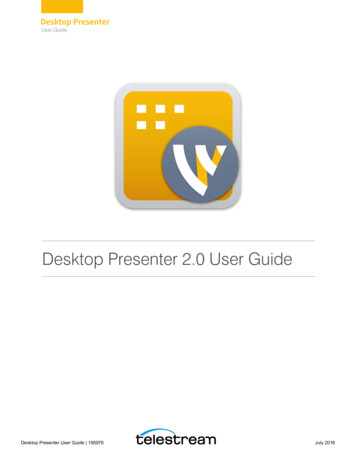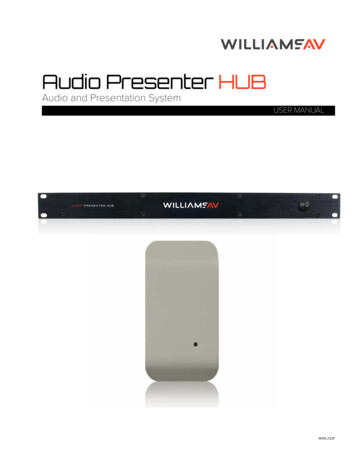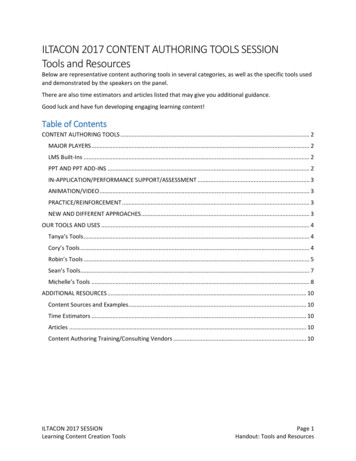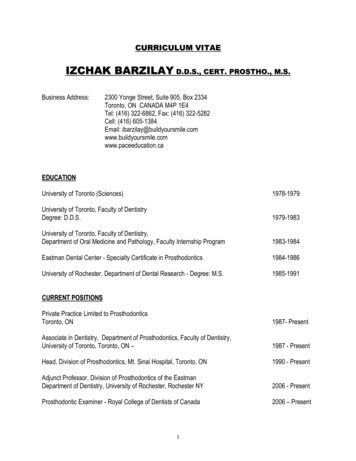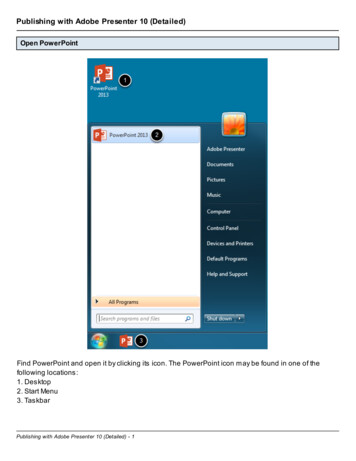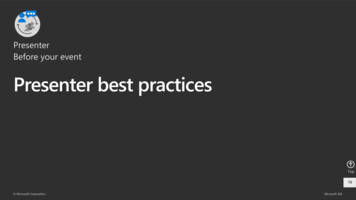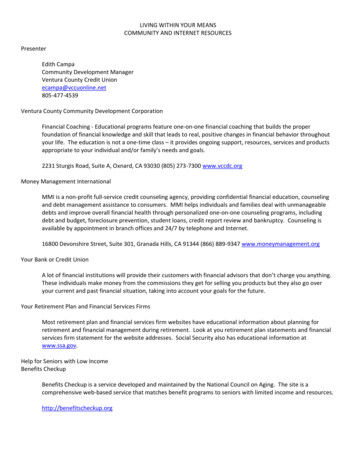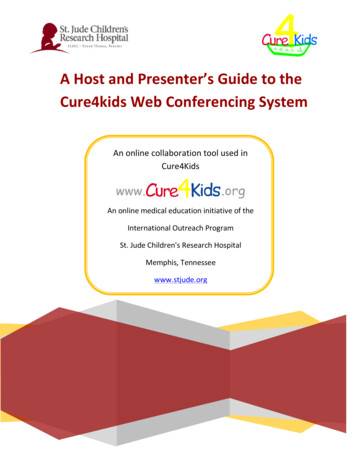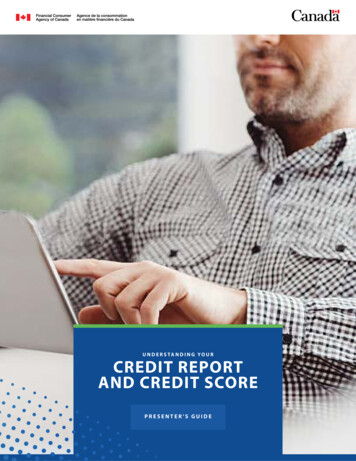
Transcription
U N D E R S TA N D I N G YO U RCREDIT REPORTAND CREDIT SCOREPRESENTER’S GUIDE
UNDERSTANDING YOUR CREDIT REPORTAND CREDIT SCORE PRESENTER’S GUIDEIntroductionWelcome to the Understanding Your Credit Report and Credit Score presentation,and thank you for agreeing to be a presenter. By delivering this workshop, you arehelping Canadians better understand their fnances and manage their debt.This manual contains all the instructions and information you will need to give thepresentation. If you have any questions, please contact us at info@fcac-acfc.gc.ca.Have fun!Materials you’ll need This manual. A projection system with the Microsoft PowerPoint fle “Understanding YourCredit Report and Credit Score Presentation” uploaded to a personal computer. Evaluation form (one copy per participant). (Optional) Summary handout (one copy per participant). (Optional) TransUnion or Equifax credit report application form(one copy per participant).Here are some tips to help you prepare: Read through this manual. Familiarize yourself with the PowerPoint presentation and upload it to a personalcomputer. Review the optional handout that summarizes the key content from the workshop.If you wish to hand it out, make enough copies for each participant. Review the optional activity at the end, in which participants begin the processof applying for a copy of their credit report from the credit bureaus. If you wishto use this activity, make enough copies of the application forms for eachparticipant. You may wish to have applications from both TransUnion and Equifax.2F C A C C R E D I T R E P O R T S P R E S E N TAT I O N : P R E S E N T E R ’ S G U I D ENOTES
NOTESThe presentationThis presentation is designed to educate Canadians about credit reports and creditscores, how credit reports and credit scores are created and used, why it is importantto check their credit reports annually, and how to improve their credit scores. All thecontent you need to convey to participants is covered in the PowerPoint presentation,with additional information points included in this manual.Participants will also engage in some activities designed to help them practice whatthey are learning. To help them follow through, encourage them to apply for a copyof their credit reports once the workshop is over.Because a great deal of information is being presented at once, it may be hard forparticipants to take it all in. To break up the presentation, we have inserted quickquestions and activities throughout the workshop. These are set of in boxes, witha QUICK BREAK tag. The quick breaks are meant to be done orally and should takeno more than about 30 seconds each. Most of the quick breaks ask participants to turnto a partner and share information they have learned. If you feel that this would beuncomfortable for your group, you can ask the quick break questions of the group asa whole rather than having participants form pairs. You can skip the quick breaks if youwish, but we recommend that you use them to keep participants focused.The workshop is designed to take one hour in total: 45 minutes for the actualpresentation and 15 minutes for questions and the optional activity at the end.Estimated time allocations are indicated next to each section of the workshop.Note how much time you are taking to complete each section, and try to keep tothe allotted times so you are able to cover all the material.Presenting tips Keep it moving. Encourage participants to ask questions, but don’t let too muchdiscussion slow down the pace of the workshop. Give time warnings. When participants are doing an activity, let them know beforethey start how much time they will have to complete it and remind them when it istime to wrap up the activity. A one-hour workshop can’t teach everything there is to know about credit reportsand credit scores. Show participants the Credit reports and scores section of theGovernment of Canada’s website, Canada.ca, for further information.3F C A C C R E D I T R E P O R T S P R E S E N TAT I O N : P R E S E N T E R ’ S G U I D E
NOTESEvaluationFCAC appreciates feedback on our materials and programs from both presenters andparticipants. Please send us copies of the evaluation forms and any comments of yourown so that we can continue to ofer relevant products that speak to the needs ofparticipants:Financial Consumer Agency of CanadaAttn: Consumer EducationEnterprise Building427 Laurier Avenue West, 6th FloorOttawa, ON K1R 1B9Other ways to contact FCAC: For services in English: 1-866-461-FCAC (3222) For services in French: 1-866-461-ACFC (2232) For calls from the Ottawa area or from outside Canada: 613-960-4666. Informationofcers are available from Monday to Friday, between 8:30 a.m. and 5:00 p.m.,Eastern Time. Email: info@fcac-acfc.gc.caOverviewHere is an overview of the tion10 min2-135-102Credit reportand credit scorebasics15 min14-3511-313Checking yourcredit report10 min36-4332-394Summary5 min44-4740-415Q&A10 min48426Optional activity5 min49437Contact us5 min5044F C A C C R E D I T R E P O R T S P R E S E N TAT I O N : P R E S E N T E R ’ S G U I D E
SECTION 1: INTRODUCTION (10 MINUTES)Slide 1: Title slideUnderstanding Your Credit Reportand Credit ScoreWelcome everyone and show Slide 1: Title slide.Slide 2: Section 1 – IntroductionSECTION 1:INTRODUCTION2Make the following introductory points: I’m glad you’re here to learn about credit reports and credit scores. This knowledgecan help you manage your money and improve your fnancial well-being. The presentation will be informative and interactive. You’ll do some activities to helpyou apply what you’re learning, and you’ll have time to ask questions. We need your feedback, so please fll out the evaluation that I’ll give you at the endof the presentation before you leave. As an icebreaker, ask participants– Who knows what their credit score is?– Who has reviewed their credit report in the past year?5F C A C C R E D I T R E P O R T S P R E S E N TAT I O N : P R E S E N T E R ’ S G U I D ENOTES
SECTION 1: INTRODUCTION (10 MINUTES)Slide 3: What you will learn today What are credit reports and credit scoresWHAT YOU WILL LEARN TODAY What are credit reports and credit scoresWhat information is included in a credit reportHow lenders use credit reports and credit scoresWhy you should check your credit report every yearHow to order your credit report and credit score What information is includedin a credit report How lenders use credit reportsand credit scores Why you should check yourcredit report every year How to order your credit reportand credit score3Show Slide 3: What you will learn today.?Quick quizTell participants that you’ll start with a short quiz to see what they already know aboutcredit reports and credit scores.Show Slides 4 to 13, and ask participants to call out the answers. (Alternatively, youcan ask participants to raise their hands if they think the correct answer is a, b, true,false, etc.) Show the corresponding slides with the correct answers and explain thatyou will discuss these topics in more detail later on.Slide 4: Question 1CREDIT REPORTS CAN INCLUDE(more than one answer may be correct)a.b.c.d.e.Your credit cards and loansYour mobile phone accountYour Facebook postsYour mortgageAll of the aboveCredit reports can include(more than one answer may be correct)a. Your credit cards and loansb. Your mobile phone accountc. Your Facebook postsd. Your mortgagee. All of the above46F C A C C R E D I T R E P O R T S P R E S E N TAT I O N : P R E S E N T E R ’ S G U I D ENOTES
SECTION 1: INTRODUCTION (10 MINUTES)Slide 5: Answer to question 1a. Your credit cards and loansANSWERa. Your credit cards and loansb. Your mobile phone accountd. Your mortgageb. Your mobile phone accountd. Your mortgage5Slide 6: Question 2True or false?TRUE OR FALSE?When it comes to credit scores,the lower the number, the better.When it comes to credit scores, the lowerthe number, the better.6Slide 7: Answer to question 2False:ANSWERThe higher the credit score, the better.FALSE:The higher the credit score, the better.77F C A C C R E D I T R E P O R T S P R E S E N TAT I O N : P R E S E N T E R ’ S G U I D ENOTES
SECTION 1: INTRODUCTION (10 MINUTES)Slide 8: Question 3MISSED PAYMENTS GENERALLY STAYON YOUR CREDIT REPORTa.b.c.d.For 1 yearFor up to 6 yearsForeverOnly as long as you want them toMissed payments generally stay onyour credit reporta. For 1 yearb. For up to 6 yearsc. Foreverd. Only as long as you want them to8Slide 9: Answer to question 3ANSWERb. For up to 6 yearsb. For up to 6 years, though this can varydepending on the type of information,the credit bureau and the province youlive in.9Slide 10: Question 4True or False?TRUE OR FALSE?To build a credit history, you shouldapply for every type of credit card youcan get your hands on.To build a credit history, you should applyfor every type of credit card you can getyour hands on.108F C A C C R E D I T R E P O R T S P R E S E N TAT I O N : P R E S E N T E R ’ S G U I D ENOTES
SECTION 1: INTRODUCTION (10 MINUTES)Slide 11: Answer to question 4False:ANSWERFALSE:To build a credit history, you need to use different typesof credit over time.However, you shouldn't apply for too many sources of creditwithin a short period of time.To build a credit history, you need to usediferent types of credit over time.However, you shouldn’t apply for toomany sources of credit within a shortperiod of time.11Slide 12: Question 5True or False?TRUE OR FALSE?You have to pay to order your creditreport from a credit bureau.You have to pay to order your creditreport from a credit bureau.12Slide 13: Answer to question 5True and FalseANSWERTRUE AND FALSE:You don't have to pay when you order your credit reportby mail or phone. If you order your credit report using oneof these methods, you'll get it by mail.You may have to pay to get your credit report instantly online(It is free from TransUnion once per month), and you usuallyhave to pay to get your credit score.You don’t have to pay when you orderyour credit report by mail or phone. Ifyou order your credit report using oneof these methods, you’ll get it by mail.You may have to pay to get your creditreport instantly online, and you usuallyhave to pay to get your credit score.139F C A C C R E D I T R E P O R T S P R E S E N TAT I O N : P R E S E N T E R ’ S G U I D ENOTES
SECTION 1: INTRODUCTION (10 MINUTES)FCAC Web Content Remind participants that this workshop will cover the most important informationthey need to know about credit reports and credit scores. Tell them they can access free web content from the Credit reports and scores sectionof the Government of Canada website, http://www.canada.ca/money, for moredetailed information. If you have access to the Internet, you may wish to display FCAC’s video on CreditReports and Scores .html).You can introduce the video by saying:“The Financial Consumer Agency of Canada has created a video to helpdemonstrate the importance of credit reports and scores. Let’s fnd out whatyour credit report says about you.” You may also wish to display FCAC’s infographic Credit Reports Matter eport.html). Let participants know that the information being provided has been confrmedwith the credit bureaus. Some information regarding credit reports and scoresis proprietary and can’t be disclosed by the credit bureaus. If you receive questionsthat you can’t answer, or for which an answer can’t be found on the Governmentof Canada’s website, Canada.ca, please forward the question(s) to the FinancialConsumer Agency of Canada at info@fcac-acfc.gc.ca.10F C A C C R E D I T R E P O R T S P R E S E N TAT I O N : P R E S E N T E R ’ S G U I D ENOTES
SECTION 2: CREDIT REPORT ANDCREDIT SCORE BASICS (15 MINUTES)Slide 14: Section 2 – Credit Reportand Credit Score BasicsSECTION 2:CREDIT REPORT ANDCREDIT SCORE BASICS14Types of Credit sk participants to name different types of credit they have used or know of. AnswersAcould include: Credit cards Store credit cards Personal loans Car loans Student loans Mortgages Lines of creditWhat is a credit report?A credit report is a summary of your credit history — that is, your record of borrowingmoney.11F C A C C R E D I T R E P O R T S P R E S E N TAT I O N : P R E S E N T E R ’ S G U I D ENOTES
SECTION 2: CREDIT REPORT ANDCREDIT SCORE BASICS (15 MINUTES)Slide 15: What is a credit report? Summary of your credit historyWHAT IS A CREDIT REPORT? Summary of your credit history Compiled by Canada’s credit bureaus:– Equifax– TransUnion Based on information submitted by lenders and othercompanies, such as banks, credit card companies andtelecommunications companies Compiled by Canada’s credit bureaus:– Equifax– TransUnion Based on information submitted bylenders and other companies, suchas banks, credit card companies andtelecommunication companies15Show Slide 15: What is a credit report?, and go over the following information points: A credit report is a summary of your credit history—that is, your record ofborrowing money in the past. It is created when you borrow money or apply for credit for the first time. Lenders send information about your accounts to companies called creditbureaus, or credit reporting agencies. The credit bureaus compile the information into an ongoing record of howyou use credit. In Canada, there are two main credit bureaus: TransUnion and Equifax.What information is included in a credit report? Tell participants that you will go over the contents of a credit report in moredetail later on. Explain that a credit report shows what credit you have applied for in the pastand whether you have ever been refused credit.12F C A C C R E D I T R E P O R T S P R E S E N TAT I O N : P R E S E N T E R ’ S G U I D ENOTES
SECTION 2: CREDIT REPORT ANDCREDIT SCORE BASICS (15 MINUTES)Slide 16: What’s included in your credit report? When you opened each accountWHAT’S INCLUDED IN YOURCREDIT REPORT? When you opened each accountHow much you oweWhether you make payments on timeWhether you miss paymentsWhether you go over your credit limit How much you owe Whether you make payments on time Whether you miss payments Whether you go over your credit limit16Show Slide 16: What’s included in your credit report? Explain that a credit reportincludes both positive and negative information about your credit card and loanaccounts: When you opened each account How much you owe Whether you make payments on time Whether you miss payments Whether you go over your credit limitIt also includes some personal information, which we’ll cover later inthe presentation.Point out that the credit report may also include information about your mobilephone account, as well as any chequing or savings accounts that have been closed “forcause” because of money owing or fraud. It may also include information about yourmortgage, if your mortgage lender sends such information to the credit bureaus.13F C A C C R E D I T R E P O R T S P R E S E N TAT I O N : P R E S E N T E R ’ S G U I D ENOTES
SECTION 2: CREDIT REPORT ANDCREDIT SCORE BASICS (15 MINUTES)Quick BreakHave participants turn to a partner and complete the sentence:A credit report is[Answers could include: a record of your borrowing, a summary of your credit history, areport that shows how much you have borrows and information about your accountsand loans.]Slide 17: What is a credit score?WHAT IS A CREDIT SCORE? A number showing how well youuse credit Scale from 300 to 900 points Ratings range from poor to excellent,or very poor to very good Best score is 900 A number showing how well youuse credit Scale from 300 to 900 points Ratings from poor to excellent,or very poor to very good Best score is 90017What is a credit score?Show Slide 17: What is a credit score?, and go over the following information points: A credit score is a number that rates how well or how poorly you use credit. It’sbased on the information in your credit report You get points for using credit responsibly—for example, by making your paymentsin full and on time. You lose points if you don’t manage credit in a responsible way—for example, bymaking late payments or going over your credit limit. The credit bureaus have proprietary systems for determining credit scores. In Canada, credit scores range from 300 points (poor) to 900 points (excellent).The best score is 900 points.14F C A C C R E D I T R E P O R T S P R E S E N TAT I O N : P R E S E N T E R ’ S G U I D ENOTES
SECTION 2: CREDIT REPORT ANDCREDIT SCORE BASICS (15 MINUTES)Show Slides 18 and 19: Sample credit score – Equifax, and explain that these twoslides show a sample credit score from Equifax.Point out (1) the score summary; (2) the loan risk rating; and (3) the delinquency ratesgraph. Point out that, in this example using Equifax’s system, a credit score of 750 isconsidered to be Very Good.Slide 18: Sample credit score – EquifaxSAMPLE CREDIT SCORE – EQUIFAX[Screen shot of Equifax loan risk ratingand delinquency rates graph]18Slide 19: Sample credit score – EquifaxSAMPLE CREDIT SCORE – EQUIFAX[Screen shot of Equifax loan risk ratingand delinquency rates graph]1915F C A C C R E D I T R E P O R T S P R E S E N TAT I O N : P R E S E N T E R ’ S G U I D ENOTES
SECTION 2: CREDIT REPORT ANDCREDIT SCORE BASICS (15 MINUTES)Slide 20: Sample credit score – TransUnionSAMPLE CREDIT SCORE – TRANSUNION[Screen shot of TransUnion credit score,showing score, percentage ranking andcreditworthiness rating]20Show Slide 20: Sample credit score – TransUnion, and explain that this is a samplecredit score from TransUnion, as shown in FCAC’s web content.Point out (1) the score; (2) the percentage ranking; and (3) the creditworthiness rating.Point out that, in this example using TransUnion’s system, a score of 700 is consideredto be Fair.Quick BreakAsk participants: True or false?If you have a credit score of 500, banks are likely to lend you money with good terms.[Answer: False. For both TransUnion and Equifax, 500 would be Poor.]Who uses your credit report? The credit bureaus sell credit reports to their members: banks, credit unions, otherfnancial institutions, credit card companies, auto leasing companies and retailers. Mobile phone companies, insurance companies, governments, employers andlandlords are also allowed to see your credit report.16F C A C C R E D I T R E P O R T S P R E S E N TAT I O N : P R E S E N T E R ’ S G U I D ENOTES
SECTION 2: CREDIT REPORT ANDCREDIT SCORE BASICS (15 MINUTES)Slide 21: How are your credit reportand credit score used?HOW ARE YOUR CREDIT REPORTAND CREDIT SCORE USED? Determine if you are a high or low risk for creditSet the interest rate you will be chargedSet your credit limitConsider you for rental housing or a jobHow much you pay for insurance (in some provinces) Determine if you are a high or low riskfor credit Set the interest rate you will be charged Set your credit limit Consider you for rental housing or a job How much you pay for insurance(in some provinces)21How are your credit report and credit score used?Show Slide 21: How are your credit report and credit score used?, and go over thefollowing information points: Businesses use your credit report and credit score to see how risky it would be forthem to lend you money. Lenders may use your credit score to set your interest rate and credit limit. If you have a low credit score, you are considered a high risk, and you maybe charged a higher interest rate on a loan or given a lower credit limit. If you have a high credit score, you are considered a low risk, and you maybe charged a lower interest rate and/or given a higher credit limit. Businesses may also use your credit report to consider whether they will hire you fora job, or a landlord could use your credit report to determine whether to rent you ahouse or apartment. Employers may want to know how you manage your own money, especiallyif the job involves handling cash or fnances. In some provinces, insurance companies may check your credit scoreto determine how much you pay for insurance. Contact your provincial insuranceregulator to fnd out whether this applies in your province.17F C A C C R E D I T R E P O R T S P R E S E N TAT I O N : P R E S E N T E R ’ S G U I D ENOTES
SECTION 2: CREDIT REPORT ANDCREDIT SCORE BASICS (15 MINUTES)Quick BreakHave participants tell a partner one thing a credit report and credit score could beused for.[Answers could include: see if you are a high or low risk for credit, set the interest ratefor a loan, set your credit limit and consider you for a job.]What information is included in a credit report?Point out that earlier slides showed the main items in a credit report. Slides 22 through25 look at the details.There are two main categories of information in a credit report, your personalinformation and your credit history.Slide 22: Part 1: Personal information NamePART 1: PERSONAL INFORMATION NameAddressPhone numbersDate of birthSocial Insurance NumberEmployment Address Phone numbers Date of birth Social insurance number Employment22Show Slide 22: Part 1: Personal information, and explain that the personalinformation section of a credit report may contain the following information: Name, date of birth, address, phone numbers, social insurance number Current and previous employers18F C A C C R E D I T R E P O R T S P R E S E N TAT I O N : P R E S E N T E R ’ S G U I D ENOTES
SECTION 2: CREDIT REPORT ANDCREDIT SCORE BASICS (15 MINUTES)Slide 23: Part 2: Credit history Credit accounts and transactionsPART 2: CREDIT HISTORY Credit accounts and transactionsMobile phone accountsNegative banking informationPublic records and registered itemsDebts sent to collection agenciesCredit checks by lendersStatements and alerts Mobile phone accounts Negative banking information Public records and registered items Debts sent to collection agencies Credit checks sent by lenders Statements and alerts23Show Slide 23: Part 2: Credit history, and explain that the credit history sectionof a credit report may contain the following information: Credit accounts and transactions Mobile phone accounts Negative baking information closed “for cause” because of money owing or fraud,and NSF cheques Public records, such as bankruptcy and legal judgments, and registered items, suchas a lien on a car or house Debts sent to collection agencies Credit checks by lenders Consumer statements, fraud alerts and identity verifcation alerts19F C A C C R E D I T R E P O R T S P R E S E N TAT I O N : P R E S E N T E R ’ S G U I D ENOTES
SECTION 2: CREDIT REPORT ANDCREDIT SCORE BASICS (15 MINUTES)Slide 24: Sample credit history – EquifaxSAMPLE CREDIT HISTORY - EQUIFAX[Screen shot of a portion of the credithistory section of an Equifax credit report]24Show Slide 24: Credit history – Equifax. Explain that this is a screen shot of part of theCredit history section of an Equifax credit report, just to familiarize participants withwhat it looks like. Point out that the Credit history section of the TransUnion reportcontains similar information.Quick BreakAsk participants: True or false?A credit report contains only a record of your failure to pay bills, not a record of whenyou have paid on time[Answer: False. It contains both positive and negative information.]20F C A C C R E D I T R E P O R T S P R E S E N TAT I O N : P R E S E N T E R ’ S G U I D ENOTES
SECTION 2: CREDIT REPORT ANDCREDIT SCORE BASICS (15 MINUTES)Slide 25: How long does information stay onyour credit report?HOW LONG DOES INFORMATION STAYON YOUR CREDIT REPORT? Varies according to type of information, provinceor territory and credit bureau Examples:– Negative information about credit cards and loans:6 years– Credit checks by lenders: Equifax – 3 years;TransUnion – 6 years– Bankruptcy: 6 or 7 years Varies according to type of information,province or territory and credit bureau Examples:– Negative information about creditcards and loans: 6 years– Credit checks by lenders: Equifax – 3years; TransUnion – 6 years– Bankruptcy: 6 or 7 years25Show Slide 25: How long does information stay on your credit report?, and go overthe following information points: By law, negative information may be kept on your credit report for only a certainlength of time. The exact amount of time varies by category, by province or territory, and bycredit bureau. For example:– Negative information about accounts such as credit cards and loans may be keptfor 6 years.– For credit checks by lenders, Equifax keeps this information for 3 years, whileTransUnion keeps it for 6 years.– Bankruptcy stays on your report for 6 or 7 years, depending on the province.21F C A C C R E D I T R E P O R T S P R E S E N TAT I O N : P R E S E N T E R ’ S G U I D ENOTES
SECTION 2: CREDIT REPORT ANDCREDIT SCORE BASICS (15 MINUTES)Slide 26: Calculating your credit score Payment historyCALCULATING YOUR CREDIT SCORE Payment historyUse of available creditLength of credit historyNumber of credit checksTypes of credit Use of available credit Length of credit history Number of credit checks Types of credit26Calculating your credit scoreShow Slide 26: Calculating your credit score, and explain that the main factors that thecredit bureaus use to calculate your credit score are: Payment history Use of available credit Length of credit history Number of credit checks Types of creditQuick BreakAsk participants which factor they think is the most important.[Answer: Payment history.]22F C A C C R E D I T R E P O R T S P R E S E N TAT I O N : P R E S E N T E R ’ S G U I D ENOTES
SECTION 2: CREDIT REPORT ANDCREDIT SCORE BASICS (15 MINUTES)Slide 27: Payment history – what can damageyour credit score? Late paymentsPAYMENT HISTORY – WHAT CANDAMAGE YOUR CREDIT SCORE? Late paymentsMissed paymentsDebts sent to a collection agencyBankruptcyPayments withheld because ofa dispute Missed payments Debts sent to a collection agency Bankruptcy Payments withheld because ofa dispute27Payment historyShow Slide 27: Payment history, and explain that your credit score will be damagedif you: Make late payments or miss payments Have debts, including parking tickets and other fnes, sent to a collection agency.Negative baking information closed “for cause” because of money owing or fraud,and NSF cheques Declare bankruptcy Withhold payments because of a dispute and the lender reports your paymentsas late23F C A C C R E D I T R E P O R T S P R E S E N TAT I O N : P R E S E N T E R ’ S G U I D ENOTES
SECTION 2: CREDIT REPORT ANDCREDIT SCORE BASICS (15 MINUTES)Slide 28: TipsTIPS Always make payments on time and in full If you can’t pay in full, make at least the minimum payment If you can’t make the minimum payment, contact the lenderright away– Ask if you can make a special arrangement to pay offthe debt Always make payments on timeand in full If you can’t pay in full, make at leastthe minimum payment If you can’t make the minimum payment,contact the lender right away– Ask if you can make a specialarrangement to pay of the debt28Show Slide 28: Tips, and explain that following these tips can improve your paymenthistory and thus your credit score: Always make your payments on time and in full. If you can’t pay the full amount, make at least the minimum payment. If you think you’ll have trouble paying a bill, contact the lender right away. See ifyou can work out a special arrangement to pay of your debt.24F C A C C R E D I T R E P O R T S P R E S E N TAT I O N : P R E S E N T E R ’ S G U I D ENOTES
SECTION 2: CREDIT REPORT ANDCREDIT SCORE BASICS (15 MINUTES)Slide 29: Use of available creditUSE OF AVAILABLE CREDIT Available credit total of the creditlimits for all your credit products Available credit total of the creditlimits for all your credit products Use a large % of your available credit– greater risklower score Use a large % of your available credit– Greater risk lower score Use a lower % of your available credit– Lower risk higher score Use a lower % of your available credit– lower riskhigher score29Use of available creditShow Slide 29: Use of available credit, and go over the following information points: To fgure out your available credit, add up the credit limits for all your credit cards,lines of credit and other loans. When you use a large percentage of your available credit, lenders see you as agreater risk, even if you pay your balance in full by the due date.25F C A C C R E D I T R E P O R T S P R E S E N TAT I O N : P R E S E N T E R ’ S G U I D ENOTES
SECTION 2: CREDIT REPORT ANDCREDIT SCORE BASICS (15 MINUTES)Slide 30: TipTIP Try to use less than 35% of yourtotal available credit Example:– Credit card limit 5,000– Line of credit limit 10,000– Total available credit 15,000– 35% of 15,000 5,250 Try to use less than 35% of your totalavailable credit Example:– Credit card limit 5,000– Line of credit limit 10,000– Total available credit 15,000– 35% of 15,000 5,25030Show Slide 30: Tip, and go over the following information points: Try to use less than 35% of your available credit. Example: If you have a credit card with a limit of 5,000 and a line of credit with alimit of 10,000, your available credit is 15,000. Multiply that amount by 35%.Try not to borrow more than 5,250 at any time (35% of 15,000). Don’t request more credit to try to bring your credit usage below 35%. Try to staywithin your current limit.26F C A C C R E D I T R E P O R T S P R E S E N TAT I O N : P R E S E N T E R ’ S G U I D ENOTES
SECTION 2: CREDIT REPORT ANDCREDIT SCORE BASICS (15 MINUTES)Slide 31: Tip Keep an older account o
You have to pay to order your credit report from a credit bureau. Slide 13: Answer to question 5 . ANSWER TRUE AND FALSE: You don'thave to pay when you order your credit report by mailor phone. If you order your credit report using one of these methods, you'll get it by mail.
